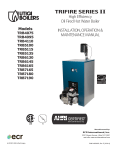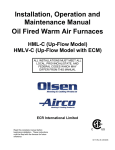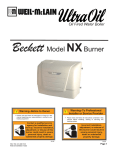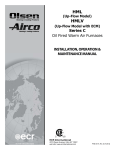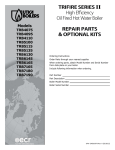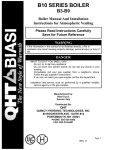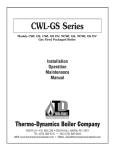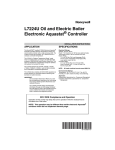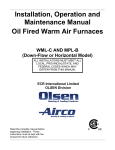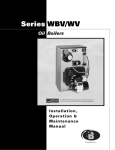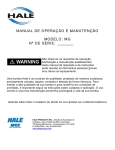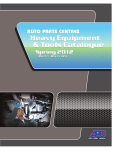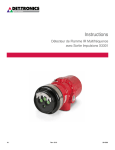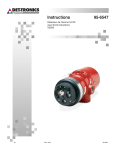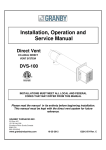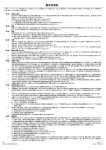Download Utica Boilers TriFire TRB 3 Operation and Installation Manual
Transcript
SUPPLEMENTAL INSTRUCTIONS: DIRECT VENT INSTRUCTIONS FOR HIGH EFFICIENCY OIL-FIRED HOT WATER BOILER Information contained in this manual pertains to direct vent boilers equipped with manufacturer installed blocked vent safety control system (pressure switch). ! WARNING Installations of venting shall be done only by a qualified expert and in accordance with these instructions. Venting a boiler or any other oil appliance with improper methods or materials may result in serious injury or death due to fire or to asphyxiation from poisonous gases such as carbon monoxide which is odorless and invisible. Keep area around vent terminal free of snow, ice, and debris. Direct Venting Of Oil Fired Boilers ..................................................................................... 2 Vent Terminal Locations ................................................................................................... 3 Vent Terminal Installation ................................................................................................ 4 Intake Air Pipe Installation ............................................................................................... 5 Vent Pipe Installation ...................................................................................................... 6 Blocked Vent Safety Shutoff System.................................................................................. 7 Sequence Of Operation ................................................................................................... 8 Final Check Out .............................................................................................................. 9 Burner Settings Tables .................................................................................................. 10 Burner Settings Tables .................................................................................................. 11 Wiring Diagrams........................................................................................................... 12 Operation And Troubleshooting ....................................................................................... 14 P/N# 240009355, Rev. B [08/2012] DIRECT VENTING OF OIL FIRED BOILERS Introduction F. Less than 1 foot (0.3m) above grade level within 6 feet (1.80m) of any combustion air inlet, unless appliance is otherwise certified. G. Within 6 feet (1.80m) of property line. H. Underneath veranda, porch, or deck. I. So the flue gases are directed at combustible material or at any openings of surrounding buildings that are within 6 feet (1.80m). J. Less than 3 feet (1m) from inside corner of L-shaped structure. K. So the bottom of the vent termination opening is less than 1 foot (0.3m) above any surface that may support snow, ice, or debris. L. So the flue gases are directed towards bricks, siding, or other construction, in such a manner that may cause damage from heat or condensate from flue gas. M. Within 4 feet (1.2m) of power venter. • Direct Vent refers to sealed combustion system. • Direct Vent series is ideal for applications where a conventional chimney is unavailable, not easily installed; electrically heated home being retrofit for oil forced air heating for example. • Direct vented appliances require planning, the range of flue lengths is restricted, clearances are critical, and national and local codes are strict with respect to safety. • Be sure the Boiler can be installed within homes physical limitations, and accordance with local codes and regulations. Physical limitations include sufficient clearance to grade. Avoid vent termination locations subject to frequent strong wind gusts. • See Table 1 for approved venting. Oil Burners USA Installation Beckett NX and Riello’s 40BF series Oil burners, are certified for venting through the wall using ducted outdoor air for combustion. Refer to figure 3, vent terminal shall not terminate: A. Less than 7 feet (2.13m) above any adjacent public walkway. B. Less than 4 feet (1.22m) below, 4 feet horizontally, or 1 foot (0.3m) above door, window, or gravity air inlet of the structure. C. Less than 1 foot (0.3m) above grade. D. Less than 1 foot (0.3m) from soffit or roof of structure. E. Less than 3 feet (0.9m) from inside corner of L shaped structure. F. Less than 5 feet (1.6m) of gas regulator vent outlet, or oil tank vent outlet. G. Underneath veranda, porch or deck. Standard Beckett AFG Series and Riello 40F Series are not certified for use, in direct vent applications. The oil burner contains a probe to measure overfire pressure and a pressure switch which does not permit burner to operate if intake or exhaust are blocked. Vent Terminal Installation Requirements Through the wall termination installation shall conform to requirements of authority having jurisdiction or in absence of such requirements • Canada Current Edition of Canadian Standards Association CSA B139, • United States ANSI/NFPA 31. Figure 1 - Standard Vent Terminal Assembly Canadian Installation Refer to figure 2, vent terminal shall not terminate : A. Directly above paved sidewalk or paved driveway that is located between two buildings, and serves both. B. Less than 7 feet (2.13m) above any paved sidewalk or paved driveway. C. Within 6 feet (1.80m) of a window, door, or mechanical air supply inlet to any building, including soffit openings. D. Above gas/regulator assembly within 3 feet (1m) horizontally of center-line of regulator. E. Within 6 feet (1.80m) of any gas service regulator vent outlet or within 3 feet (1m) of any oil tank vent or any oil tank fill inlet. 2 VENT TERMINAL LOCATIONS Figure 2 - Vent Terminal Locations (Canada) C C J C C M D&E B Forced air inlet F&K Figure 3 - Vent Terminal Location (USA) 3 VENT TERMINAL INSTALLATION Vent Terminal Location Figure 4 - Inside View of Vent Terminal See table 1 for equipment certified for use with this appliance. Select location of wall penetration that conforms to code for exterior location: 1. As close to appliance as possible, 2. Maintains clearance to combustibles, 3. Maintains minimum 1/4 inch per foot slope back to appliance. 4. Install vent terminal in wall having minimum thickness of 5”, and maximum thickness of 10”. Vent Terminal Installation • Cut a 6-1/2” diameter hole through the wall. • Remove Intake Air Sleeve from Terminal. • Insert Terminal through the wall from outside, secure with 4 screws to the wall, and seal to wall with weatherproof sealant. • From inside the building, re-attach Intake Air Sleeve and secure inner sleeve to outer sleeve with 2 screws. • Use 4 screws to secure Sleeve to wall. See Figure 4. • Insure Intake Air Connector is located for easy attachment and complies with code. Vent Terminal Riser Kit Figure 5 - Vent Terminal Riser Kit is designed to increase height of vent terminal by approximately 3 feet. Ideal where excessive snow build up could occur or where more flexibility is required to maintain minimum clearances at grade. See figure 5. 4 INTAKE AIR PIPE INSTALLATION Direct Vent Intake Air Pipe Installation Do not use Flexible duct for combustion air. Outdoor air for combustion must be used. Oil burners approved for use with outdoor air for combustion are Beckett NX and Riello 40BF. Outdoor air is obtained using the following materials/ methods. Acceptable combustion air intake materials are listed below. Beckett NX Burner : • 4 inch “C” Vent (single wall galvanized). • 4 inch Rigid Aluminum pipe (0.030” wall thickness). Riello 40BF Burner : • 4 inch “C” Vent (single wall galvanized). • 4 inch Rigid Aluminum pipe (0.030” wall thickness). Use 4 inch pipe from the terminal to appliance. Reduce to 3 inch pipe to attach to burner inlet collar. NOTICE Seal intake pipe and fittings with foil tape, duct tape, or silicone caulking and attached mechanically with screws. Maximum combustion air intake length is 25 feet using eight 90° elbows. Combustion air intake does not have minimum length. Condensation may become a concern during some climatic conditions. It may be necessary to wrap a portion, or entire intake piping (particularly metal intake piping) with waterproof insulation material. 5 VENT PIPE INSTALLATION Venting Installation - Direct Vent Figure 6 - Appliance Connector w/ Test Port ! WARNING Improper installation, adjustment, alteration, service or maintenance could result in death or serious injury. Do not enclose vent. Do not route vent through walls, floors or ceilings. Venting and vent terminal are dedicated to the Boiler only; do not attempt to vent any other appliance through it. Flexible Vent Installation Supplied flexible exhaust duct is a double wall, one (1) inch clearance to combustibles, flexible venting material. Inner pipe is constructed of 4 inch inside diameter 316 stainless steel, with two-ply aluminum outer pipe. High temperature insulation separates inner and outer flex pipes. Figure 7 - Male End Vent installation shall conform to requirements of authority having jurisdiction or in absence of such requirements NFPA 31 Installation Of Oil Burning Equipment (U.S.) or CSA B139 (Canada) and applicable provisions of local building codes and these instructions. ! CAUTION Use appropriate safety precautions. Thin metal edges are extremely sharp. If not avoided, could result in minor or moderate injury. 1. In as short and straight a run as possible without any unnecessary bends. 2. No dips or sags throughout full length of vent. 3. Slope connector or vent upwards from appliance at least 1/4” per foot. 4. Do not bend connector or vent more than 90°. 5. May cut vent to a minimum of 5 feet in length using fine tooth (24 teeth per inch) hacksaw blade. 6. Clean male and female ends of the appliance adapters and connectors with residue free brake cleaner solvent. 7. Apply minimum 1/4” bead of Si-Ultra Copper Sealant provided, onto outside of male end of vent to appliance connector. Fit connector to vent by threading it counter-clockwise until it stops. Insure joint is not cross-threaded. Tighten gear clamp on outer cover. See figures 7, 8 & 9. 8. Apply minimum 1/4” bead of same sealant on female end inside of connector. Slip connector over end of appliance collar until it stops. Tighten attached gear clamp. See Figure 8. 9. Support Vent every 36” to prevent sagging. 10. Attach Terminal Connector as described in steps listed above. 11. Maximum vent length is 20 feet (using 20 foot vent kit). Piecing vent kits together (i.e. using 2 ten foot kits) is strictly prohibited. Figure 8 - Female End 6 BLOCKED VENT SAFETY SHUTOFF SYSTEM Blocked Vent Safety Shut Off System (BVS) Beckett NX Burner: Direct vent Boiler is equipped with Blocked Vent Safety shut off system (BVS). Safety circuit shuts burner off in event of combustion air blockage or venting blockage. Refer to Table 2. Select head setting according to required firing rate. Final adjustments are required once burner is started. It is best to have burner shutter and or head settings close to Table 2 or 3. Final Adjustments • Tighten lock nuts and screws before making measurements. • Using suitable testing instruments for CO2 (or O2), measure combustion products. CO2 in the stack should be minimum of 12% CO2 at a trace of smoke. For clean operation of burner, open air control to introduce enough excess air into the system to reduce CO2 by 10% of original trace point. EXAMPLE: 12% CO2 minus 1.2 (which is 10% of 12) equals 10.8% CO2). Beckett NX BVS pressure switch is wired in series with CAD cell. See Wiring Diagram, Figure 12. Riello 40BF BVS pressure switch is wired in series with terminals 10 and 11 on 530SE control. See Wiring Diagram, Figure 13. Riello 40BF Burner: Blocked Vent Safety Switch Pressure Tubing Connections Refer to Figure 10. Check initial air shutter and head settings. Remove burner cover and turn air shutter adjustment screw (2) until top edge of air shutter (3) is in alignment with corresponding number in Table 3. Check tubing connections on all Boilers prior to firing unit. Beckett NX has low and high side tube, vacuum side goes to air intake box, pressure side goes to overfire pressure probe. See Figure 11. Riello BF low pressure side is open inside air tight burner cover and high pressure side goes to overfire pressure probe. NOTICE Riello burner pressure gauge threads are British Parallel Thread design. Test gauge with NPT fitting ruins pump body. Use Riello pressure gauge or adapter. Verify burner cover is air tight and all hole plugs are in place. Further adjustments must be made with burner cover in place by unscrewing plug on cover. Turn screw clockwise to increase combustion air or counter clockwise to decrease combustion air. Oil Burner Operation Once Boiler flue pipe and intake pipe are completely installed. In absence of burner manufacturer’s instructions, use following instructions to set burner: • Shutter final position will vary on each installation. • Use instruments to establish proper settings for maximum CO2 and smoke spot reading of zero. • Re-insert plastic cap over air adjustment hole before any measurements. • Shut off electrical power to Boiler. • Install oil pressure gauge to pressure port on oil pump. (Riello requires special adapter) • Check air settings for initial firing in Table 2 or 3. • Restore electrical power to Boiler. • Start Boiler. Bleed all air from fuel oil lines. • Close purge valve and fire unit. • When Boiler has reached “steady state” (after approximately 5 minutes), remove bolt (test port) from center of Appliance Adapter to Boiler. • Set combustion air control to get TRACE to ZERO smoke. 7 SEQUENCE OF OPERATION Beckett NX 1. 2. 3. 4. 5. 6. 7. 8. 9. 10. Figure 9 - Flex Vent Assembly Detail Room temperature drops, thermostat calls for heat. Pre-purge begins, lasting 5 to 15 seconds. Oil solenoid and BVS are energized Oil Solenoid opens allowing oil to reach Burner Electrodes. Burner ignition begins. If vent is clear, pressure switch closes, Cad cell detects light from combustion the primary control safety circuit disconnects allowing combustion to continue. BVS is energized. After 15 to 45 seconds (depending on primary control characteristics), electric spark across electrode tips stops, combustion continues. Boiler continues operation and reaches “steady state”, point at which system temperature stabilizes. Room temperature rises, thermostat is satisfied, heating contacts open. Oil solenoid valve closes, combustion stops, burner motor remains on to complete Post Purge Cycle. Post Purge time can be 0 to 8 minutes depending on settings. Factory default is 2 minutes. Timing can be changed using Beckett 5206 Genisys display. Boiler remains idle until next call for heat. Figure 10 - Air Shutter Setting Riello 40BF 1. Room temperature drops, thermostat calls for heat. 2. Pre-purge begins, lasting 5 to 15 seconds. BVS is 3. 4. 5. 6. 7. 8. 9. 10. energized. If flue is clear, pressure switch allows ignition sequence to continue. Oil Solenoid opens allowing oil to reach burner electrodes. Burner ignition begins. Cad cell detects light from combustion, disconnects primary control safety circuit, allowing combustion to continue. After 15 to 45 seconds (depending on primary control characteristics), electric spark across electrode tips stops, combustion continues. Boiler continues to operate and reaches “steady state”, the point at which the system temperature stabilizes. Room temperature rises, thermostat is satisfied, heating contacts open. Oil solenoid valve closes, combustion stops, burner motor remains on to complete post purge cycle. Post purge time can be 10 seconds to 5 minutes depending on settings. Factory default is 45 seconds. Timing can be changed by rotating dial on Riello burner fan-off timer control board. Boiler remains idle until next call for heat. 8 FINAL CHECK OUT • Carefully examine complete vent system for leaks. This may be done by spraying soapy solution on all joints and watching for bubbles during pre-purge. The hot vent can be checked with lit taper for signs of air movement around joints or seams. • Insure all safety devices and electrical components have been set for normal operation. Insure all electrical connections are tight and wiring is secure. • Insure homeowner is informed and understands the following: 1. Where circuit breaker or fuse is located in main electrical panel. 2. Where Boiler switch is located, and switch “on” and “off” positions if not obvious. 3. Where oil shut-off valve from oil storage tank is located. 4. To keep area around vent terminal free of snow, ice, and debris. 5. How to operate the thermostat, and other related accessories. 6. How to operate manual reset button on primary control, and especially when not to push the reset button. 7. How and where to visually inspect the venting system for leaks or other problems. 8. How to inspect, clean and replace the air filter, and other homeowner maintenance procedures. 9. Who to call for emergency service and routine annual service. 10. Terms and conditions of the manufacturer’s warranty and the contractor’s warranty. 9 BURNER SETTINGS TABLES TABLE 1: THE HIGH EFFICIENCY OIL BOILER IS CERTIFIED FOR USE ONLY WITH THE FOLLOWING PART NUMBERS Items with Boiler Burner Options Item Part Number Riello 40BF 4-7/8” to 4” Appliance Adapter 240007535 Beckett NX Termination Options Part Number Vent Length Part number Options Field Supplied Items STD Terminal 28972 4” ID x 10 FT 240006909* 4x3” Single wall Reducer for Riello 36” Riser 29231 4” ID x 15 FT 240006910* 4” ID x 20 FT 240006911* Single Wall Vent 25 FT Max With Up To (8) 90 Deg. Elbows for Air Intake Pipe *Includes Terminal Adapter and Caulking p/n 240006914 TABLE 2: BECKETT DIRECT VENT PRELIMINARY BURNER SETTINGS Pressure Switch Setpoint Rated AFUE Efficiency [%] 1.5 0.65" WC 86.0 155 4.0 0.65” WC 85.0 0.75x45B 175 4.0 0.85" WC 86.5 1.00x60B 140 1.8 0.85” WC 85.0 V5 Delevan 1.10x60B 150 2.5 0.85” WC 84.0 V6 Danfoss 175 2.0 0.65" WC 86.5 Boiler Model Head Type Insertion Depth Firing Rate [GPH] Combustion liner Nozzle Mfr. Nozzle Type 4075 6 Slot 2.5" 0.75 Oval Delavan 0.60x60B 150 4095 6 Slot 2.5” 0.95 Oval Hago 0.75x60B 5100 6 Slot 2.5" 1.00 None Delavan 5115 6 Slot 2.5” 1.15 V5 Hago 5135 6 Slot 2.5” 1.35 6130 9 Slot 2.5" 1.30 Timings Pre-purge 15 seconds Post-Purge 2 minutes TABLE 2: BECKETT/ECR PART NUMBERS Boiler Model Beckett Oil Burner Model ECR Oil Burner Part Number 4075 NX70LC 240007531 4095 NX70LC 240009393 5100 NX70LC 240007532 5115 NX70LF 240009395 5135 NX70LF 240009396 6130 NX70LD 240007533 10 1.00x45B Pump Air Pressure Setting [PSI] BURNER SETTINGS TABLES Table 3: RIELLO 40BF DIRECT VENT PRELIMINARY BURNER SETTINGS Inser- Firing Comtion Rate bustion Depth [GPH] Liner Nozzle Mfr. Nozzle Type Pump Pressure [PSI] Rated Pressure AFUE Switch Efficiency Setpoint [%] Boiler Model Head Type 4075 Reverse 2.75" 0.75 Oval Delavan 0.65x60W 150 3 5.0 0.25" WC 86.0 4095 Standard 1.75" 0.95 Oval Delavan 0.75x90B 175 1 4.0 0.25" WC 85.0 4110 Standard 1.75" 1.10 Oval Delavan 1.00x90B 125 2 5.0 0.25" WC 84.0 5100 Standard 2.75" 1.00 None Delavan 0.75x60B 175 1 5.0 0.80" WC 86.5 5115 Standard 1.75" 1.15 None Delavan 1.00x80B 130 2 5.8 0.80” WC 85.0 5135 Standard 1.75" 1.35 None Delavan 1.20x80B 125 4 5.8 0.80” WC 84.0 6130 Standard 2.75" 1.30 V6 Delavan 1.00x45B 175 2 8.0 0.90" WC 86.5 Timings Pre-purge 12 seconds Post-Purge 45 seconds Riello Boiler Oil Model Burner Model ECR Oil Burner Part Number 4075 40BF3 240007528 4095 40BF5 240009407 4110 40BF5 240009408 5100 40BF5 240007529 5115 40BF5 240009409 5135 40BF5 240009410 6130 40BF5 240007530 11 Head Air Setting Setting WIRING DIAGRAMS Figure 11 - Beckett NX With Blocked Flue Pressure Switch Safety Figure 12 - Wiring Diagram: Beckett NX With GenisysTM 7505 (15 Seconds pre purge, 2 minutes post purge) (BLUE/WHITE) (WHITE) (ORANGE) (WHITE) (BLACK) (RED) (WHITE) (VIOLET) (WHITE) (YELLOW) 12 WIRING DIAGRAMS Figure 13 - Riello Wiring Diagram With Post Purge Timer And Blocked Flue Pressure Switch Safety If a neutral or ground lead is attached to terminal 4, the CONTROL BOX on the burner will be damaged should lockout occur. 13 OPERATION AND TROUBLESHOOTING NX Burner With Blocked Vent Safety (BVS) Operation External Action Appliance Response Power applied to burner control Internal safety check conducted. If no light or flame is detected and all internal conditions are correct, control enters idle mode. Thermostat Calls For Heat 1. Contacts between T and T on Aquastat L7248A are closed. 2. Burner Control period (4 seconds) internal and external check for flame or light. If flame is detected, control remains in idle mode. 3. When flame is not present, Burner Control will apply power to the burner motor and igniter, complete a 15 second valve on delay period and then apply power to the oil valve circuit. 4. Burner Control enters the trial for ignition period. A. Monitors burner for flame. B. When flame is not detected: I. Enters lockout mode after 15 seconds. II. Shuts off valve, igniter and burner motor. III. Flashes indicator light at 1 Hz (½ second on, ½ second off). IV. Depress reset button to return to power up sequence. C. When flame is detected, Carry-Over period begins: 5. Burner Control enters 10-second Ignition Carry-Over period. A. Turns on indicator light B. If flame is lost and lockout time has not expired, Burner Control returns to trial for Ignition period. C. If flame is lost and lockout time has expired, Burner Control enters Recycle Mode. 6. Carry-over time expires and igniter turns off. 7. Enters a run mode: A. Flame is monitored until call for heat ends or flame is lost. If flame is lost: B. Control enters Recycle Mode. I. Recycle time starts (60 seconds). II. Burner and valve are turned off. III. Indicator light flashes at ¼ Hz (2 seconds on, 2 seconds off). Call for heat is satisfied. Reset button pushed two times without device completing a call for heat. IV. Returns to Idle mode at end of Recycle mode. 1. Oil valve circuit is de-energized and valve shuts off. 2. Burner motor runs for selected post purge time. 3. Burner motor turns off. 4. Burner Control returns to Idle mode 1. Burner Control enters restricted mode. 2. Indicator light flashes 1 Hz (½ second on, ½ second off). 3. Reset device by pressing and holding reset button for a minimum of 45 seconds. GeniSys 7505 Reset Button Operations Pushing the reset button in the current state will cause the following conditions: If the burner state is: Pushing the reset button < 1 second Lockout Pushing the reset button > 1 second Reset from Restricted (Hard) Lockout Reset from Soft Lockout Valve On Delay, Trial For Ignition, Ignition Carryover Run (igniter is shut off) Pump Prime Yellow light flashes to indicate cad cell resistance. Motor-Off Delay, Standby No action Pump Prime No action Disable the Burner. Any time the burner is running, press and hold the reset button to disable the burner. The burner will remain off as long as the button is held. Enables pump priming: After the reset button has been held for 15 seconds the button can then be clicked during the next ignition sequence to enter pump prime mode. Exit pump prime mode and return to standby. Status Lights Light Color Push, hold reset button >15 seconds On Continuously Flashing Red Restricted (Hard) Lockout Soft Lockout Green Flame Sense during normal operation. May be stray light during standby. Recycle Yellow Control is in Pump Prime mode OR reset button is currently held for >15 seconds. Cad cell resistance. 14 OPERATION AND TROUBLESHOOTING Beckett NX BURNER TROUBLESHOOTING Condition 1: Burner motor does not start when there is a call for heat. Procedure Status Corrective Action 1. Check that limit switches are closed and contacts are clean. N/A N/A 2. Check for line voltage power at the oil primary control. Voltage should be 120 Vac between the black and white lead wires on the oil primary control. N/A N/A 3. Check indicator light with burner off, no call for heat (no flame). 4. Shield cad cell from external light. 5. Verify that the oil valve is closed during the valve on delay period by observing the view port and verifying that no flame is present during the 15-second valve on delay . Green Indicator light is on. Cad cell is defective, sees external light, or connections have shorted. Go to step 4. Green Indicator light is off. Go to step 6. Green Indicator light turns off. Eliminate external light source or permanently shield cad cell. Green Indicator light stays on. Replace cad cell with new cad cell and recheck. If indicator light does not turn off, remove cad cell lead wires from Aquastat and recheck. If indicator light is still on, replace the Aquastat control. If the indicator light turns off, replace cad cell bracket assembly. Green Indicator light is on. If flame is present, replace the oil valve. Burner starts. Trouble is in thermostat circuit. Check thermostat-wiring connections. If connections are clean and tight, check thermostat wires for continuity. 6. Jumper thermostat (T -T) terminals on Aquastat IMPORTANT First remove one thermostat lead wire. Burner does not start. • Disconnect line voltage power and open line switch. • Check all wiring connections. • Tighten any loose connections and recheck. • If burner still doesn’t start, replace Aquastat. If burner still doesn’t start, check the oil burner motor. It may be seized or burned out. 15 OPERATION AND TROUBLESHOOTING Condition 2: Burner starts then locks out on safety with red indicator light flashing. Procedure 1. Reset oil primary control by pushing in and releasing red reset button. 2. Listen for spark after burner turns on (after 2 second delay). 3. Check indicator light after flame is established, but before oil primary control locks out. 4. Check cad cell sighting for view of flame. • Disconnect line voltage power and open line switch. • Unplug cad cell and clean cad cell face with soft clothe. Check sighting for clear view of flame. Replace cad cell in socket. • Reconnect line voltage power and close line switch. • Start burner. 5. Check cad cell. • Disconnect line voltage power and open line switch. • Remove existing cad cell and replace with new cad cell. • Disconnect all wires from thermostat terminals to ensure that there is no call for heat. • Reconnect line voltage power and close line switch. • Expose new cad cell to bright light such as a flashlight. 6. Check cad cell bracket assembly. • Disconnect line voltage power and open line switch. • Remove cad cell wires from quick connect connectors on the Aquastat and leave control lead wires open. • Apply power to device. • Place jumper across cad cell terminals after burner motor turns on. Status Corrective Action Indicator light stops flashing. Go to Step 2. Indicator light continues to flash at 1/2 second on, 1/2 second off rate. Verify that the control is not in restricted mode. (See notes at end of this table.). If not in restricted mode, replace Aquastat Ignition is off Spark igniter could be defective. Check for line voltage at igniter terminals. If line voltage is present, replace R7484. Ignition is on. Go to Step 3. Ignition is on but no oil is being sprayed into the combustion chamber. Wait for “Valve ON” delay to complete. Check oil supply. Ensure BVS bypass contact close and bypass pressure switch for 10-seconds. After 10-seconds, check pressure switch on BVS to ensure closed. Pressure switch open. Check pressure tubes for proper connection or possible obstructions. Check venting for blockage. Check combustion air intake for blockage. Check pressure switch operation. Check oil line valve. Check for filter blockage or seized oil pump. Indicator light is on until the control locks out and starts flashing during lockout. Check Aquastat Indicator light stays off. Go to step 4. Burner locks out. Go to step 5. Burner keeps running. System is OK. Indicator light is on. Remount control onto burner housing. Go to step 6. Indicator light is off. Go to step 6. Indicator light is on. Replace cad cell bracket assembly. Indicator light is off. Replace Aquastat. NOTE: Restricted Mode - (Limited Reset): In order to limit the accumulation of unburned oil in the combustion chamber, the control can be reset only 3 times, after which, the control locks out. The reset count returns to zero each time a call for heat is successfully completed. To reset from Restricted Mode: press and hold the reset button for 30 seconds. When the LED flashes twice, the device has reset. NOTE: Disable function: Pressing and holding the reset button will disable all functions until the button is released. The burner will restart at the beginning of the normal heat cycle on safety check. 16 OPERATION AND TROUBLESHOOTING Beckett NX: System and General Troubleshooting Problem Boiler will not start. Boiler will not start without first pushing oil primary control reset button. (Happens on frequent basis) Boiler starts, but cuts out requiring manually resetting the oil protector reset button Possible Cause Remedy Thermostat not calling for heat. • Check thermostat and adjust. Also, check thermostat for accuracy; if it is a mercury switch type, it might be off level. No power to Boiler. • Check Boiler switch, main electrical panel Boiler fuse or circuit breaker. Also look for any other hand operated switch, such as an old poorly located Boiler switch, which was not removed during Boiler replacement. Thermostat faulty. • Remove thermostat wires from control terminals T-T. Place a jumper across T-T. If Boiler starts, replace thermostat, thermostat sub-base (if equipped), or both. Oil primary control faulty. • Check reset button on oil primary control. Photo Cell wiring shorted or room light leaking into photo cell compartment • Check photocell (cad cell) wiring for short circuits. Also, check for room light leaking into cad cell compartment. Repair light leak if necessary. See Table C-3. Open safety switch. • Check for open limit or auxiliary limit. Also, check internal wiring connections; loose connectors, etc. Photo Cell (Cad Cell) defective. • If call cell is dirty, clean it. (Determine why cad cell is getting dirty). If cad cell is poorly aimed, realign it. NOTE: The photocell should have a resistance of 100KΩ in absence of light; a maximum of 1500Ω in the presence of light. Ensure that room light is not leaking into the cad cell compartment. (See diagnostic light section). No fuel oil. • Check fuel oil supply. Check that all hand operated fuel oil valves are in the open position. Fill oil storage tank if necessary. Clogged nozzle. • Replace nozzle with high quality replacement. Use rating plate or Tables in Appendix A as a guide. Clogged oil filter. • Replace oil tank filter or in-line filter if used. Blocked Vent Safety Circuit opening. • Pressure switch open: • Check pressure tubes for proper connection or possible obstructions. • Check venting for blockage. • Check combustion air intake for blockage. • Check pressure switch operation. Low oil pump pressure. • Connect pressure gauge to oil pump. Adjust pump pressure, or replace oil pump if necessary. Ensure that erratic pressure readings are not caused by defective fuel oil line. Air getting into fuel oil lines, or fuel oil line dirty, clogged, or in some manner defective. • Check fuel oil lines. Replace any compression fittings found with high quality flared fittings. Check for any signs of oil leaks. Any oil leak is a potential source of air or contaminants. Defective burner motor. • Check burner motor. If burner motor is cutting out on over-load, determine why. Replace if necessary. No fuel oil. • Check fuel oil supply. Check that all hand operated fuel oil valves are in the open position. Fill oil storage tank if necessary. Clogged nozzle. • Replace nozzle with high quality replacement. Use rating plate or Tables in Appendix A as a guide. Clogged oil filter. • Replace oil tank filter or in-line filter if used. Blocked Vent Safety Circuit opening. • Check pressure switch on BVS to ensure closed. • Pressure switch open. • Check pressure tubes for proper connection or possible obstructions. • Check venting for blockage. • Check combustion air intake for blockage. • Check pressure switch operation. Low oil pump pressure. • Connect pressure gauge to oil pump. Adjust pump pressure, or replace oil pump if necessary. Ensure that erratic pressure readings are not caused by defective fuel oil line. Air getting into fuel oil lines, or fuel oil line dirty, clogged, or in some manner defective. • Check fuel oil lines. Replace any compression fittings found with high quality flared fittings. Check for any signs of oil leaks. Any oil leak is a potential source of air or contaminants. Defective burner motor. • Check burner motor. If burner motor is cutting out on over-load, determine why. Replace if necessary. Water or contaminants in oil. • Drain fuel oil storage tank, replace fuel oil. (Consult with fuel oil supplier). 17 OPERATION AND TROUBLESHOOTING Beckett NX: System and General Troubleshooting Problem Oil burner sputtering at nozzle Excessive fuel oil consumption. Too much smoke. Soot building up on blast tube (end coning). Boiler will not warm home to desired temperature. Home does not heat evenly Possible Cause Remedy Electrodes out of adjustment or defective. • Check electrode settings. Check electrodes for dirt build-up or cracks in porcelain. Poor transformer high voltage connections or defective transformer. • Check contacts between the igniter and electrodes. If OK, replace the igniter Fuel oil filter clogged. • Replace fuel oil storage tank filter and / or fuel oil in-line filter. Defective oil pump. • Check burner motor / fuel oil pump coupling. Check oil pump pressure. Replace fuel oil pump if necessary. Fuel oil line partially clogged or contains air. • Bleed air from oil line. If problem persists, replace oil line. Blocked Vent Safety Circuit opening intermittently. (Boiler lights, then turns off) • Check pressure switch on BVS to ensure it remains closed. • Pressure switch open. • Check pressure tubes for proper connection or possible obstructions. • Check venting for blockage. • Reduce burner head opening. • Check combustion air intake for blockage. • Check pressure switch operation. Fuel oil leak. • Check fuel oil line for leaks. Repair or replace if necessary. Thermostat improperly adjusted or in poor location. • Check thermostat heat anticipator setting against measured amperage draw. Increase heat anticipator setting if necessary. If the thermostat is being influenced by drafts, sunlight, duct work, etc., relocate to more suitable location. Insufficient combustion air adjustment at oil burner, or improper draft pressure. • Check CO2. Should be 11.5% to 12% Heat exchanger partially clogged. • Check for soot build-up in heat exchanger flue passages, especially in the outer radiator. Flame impingement caused by Incorrect nozzle angle. • Check nozzle size and angle. (See Appendix A). Check distance from head to inside surface of the fire pot. Thermostat adjustments or location. • Check thermostat heat anticipator setting against measured amperage draw. Increase heat anticipator setting if necessary. If the thermostat is being influenced by drafts, sunlight, duct work, etc., relocate to more suitable location. Insufficient water flow. • Check all registers. Defective high limit control. • Test high limit function of all limit switches. Use a duct thermometer to assess accuracy of limit control. Replace control if necessary. Under-sized nozzle. • Check nozzle and nozzle filter for dirt. Burner motor stopping intermittently on overload. • Check burner motor. Pressure switch opening due to blocked vent. Replace if necessary. Improper distribution of heat. • This is not likely to be a Boiler problem. Balance duct system. 18 OPERATION AND TROUBLESHOOTING Riello 40BF blocked vent safety (BVS) Operation External Action Appliance Response Thermostat calls for heat. • Burner enters pre-purge. • After pre-purge, oil valve is energized and burner lights off. • Burner operates in run mode. • Normally closed pressure switch monitors for vent or combustion air intake blockage. Call for heat is satisfied. • Oil valve circuit is de-energized and valve shuts off. • Burner motor runs for duration of burner motor-off delay. • Burner motor turns off. Pressure switch contacts open and cause burner to re-cycle. 1. Check for vent blockage. 2. Check for combustion air intake blockage. 3. Ensure pressure tubes are connected properly and clear of obstructions. 4. Check burner set up. RIELLO 40BF BURNER TROUBLESHOOTING Condition: Thermostat is calling for heat. Burner is not running. Problem Reset control box. 1. Test for 120 Vac supply at sub-base between L (P) & N or terminals #3 and #5. 2. Turn off power supply- Remove control box and jumper terminals #5 and #6. Restore power. 3. Burner Starts 4. Burner Runs, post purge successful. Aquastat Shows Error EE4. Possible Cause Remedy Burner starts. Go to step #3 Burner does not start Go to step #1 120 Vac present. Go to step #2 No voltage • Check system fuse, breaker or ensure service switch is ON. • Verify all limits are closed. • If using switching relay, verify 24 Vac at T-T. • Verify BVS pressure switch is closed. Motor runs. • Verify reduced voltage (42-52 Vac) between terminals #3 and #7. • Ensure good contact between control box spades and sub-base terminals. • Defective control box/ Replace. Motor does not run. • Verify electrical connections. • Check for seized pump, motor, or fan against housing. • Defective motor capacitor. • Thermal overload (Hot motor). Burner stays in Pre-purge. • Faulty CAD cell or seeing light before trial for ignition. • Coil wires on terminals #1 and #2 or #1 and #8 reversed. • Open coil circuit; terminals #2 and #8. • Open coil circuit; terminal #1 • Defective 42-52 Vac supply, terminals #3 and #7. • Defective control box/ Replace Burner continues to purge and light off with immediate flame dropout. • Metal yoke for coil missing. • Coil wire #2 and #8 reversed. • Low resistance of coil holding circuit, terminals #1 and #2, (1350 ohms ± 10%). • Verify BVS pressure switch is remaining closed upon light off. Burner locks out after trial for ignition. • Low resistance or no contact on starting circuit of coil, terminals #2 and #8. (1.3ohm ± %) • No oil supply- tank empty, valve closed, dirty filter, damaged supply lines. • Defective or dirty oil valve stem, nozzle, or pump strainer. • Broken pump drive key, defective pump or no oil pressure. • Ignition electrodes shorted, cracked porcelain. • Burner motor not up to speed. • Excessive draft over fire. • Defective control box/ Replace. Some Aquastats limit post purge time to 1 minute. Error unique to early models of L7248. • Reset Post purge timer on Fan Timer Board to 45 seconds. 19 OPERATION AND TROUBLESHOOTING RIELLO 40BF Blocked Vent safety system (BVS) TROUBLESHOOTING Condition: Thermostat is calling for heat. Burner is not running. Problem Test BVS pressure switch contacts are closed. Turn off power supply- Remove control box and jumper terminals #5 and #6. Restore power. Burner Starts Possible Cause Remedy Contacts closed. Go to step #2. Contacts open Verify pressure tubing is connected properly and clear of obstructions. Verify vent is not obstructed. Verify combustion air intake is not obstructed. Replace. Motor runs. Verify reduced voltage (42-52 Vac) between terminals #3 and #7. Ensure good contact between control box spades and sub-base terminals. Defective control box/ Replace. Motor does not run. Verify electrical connections. Check for seized pump, motor, or fan against housing. Defective motor capacitor. Thermal overload (Hot motor). Burner stays in Pre-purge. Faulty CAD cell or seeing light before trial for ignition. Coil wires on terminals #1 and #2 or #1 and #8 reversed. Open coil circuit; terminals #2 and #8. Open coil circuit; terminal #1 Defective 42-52 Vac supply, terminals #3 and #7. Defective control box/ Replace Burner continues to purge and light off with immediate flame dropout. Metal yoke for coil missing. Coil wire #2 and #8 reversed. Low resistance of coil holding circuit, terminals #1 and #2, (1350 ohms ± 10%). Verify BVS pressure switch is remaining closed upon light off. Burner locks out after trial for ignition. Low resistance or no contact on starting circuit of coil, terminals #2 and #8. (1.3-ohm ± %) No oil supply- tank empty, valve closed, dirty filter, damaged supply lines. Defective or dirty oil valve stem, nozzle, or pump strainer. Broken pump drive key, defective pump or oil pressure. Ignition electrodes shorted, cracked porcelain. Burner motor not up to speed. Excessive draft over fire. Defective control box/ Replace. HOMEOWNER’S REFERENCE TABLE Model No. Serial No. Date Installed Contractor Contact Address Postal Code Telephone No. After Hours No.




















